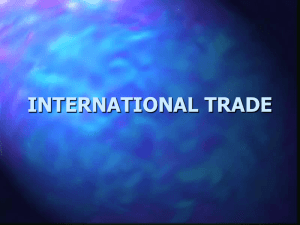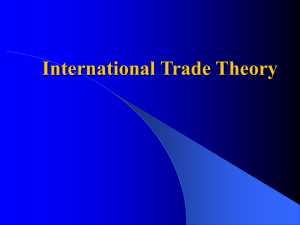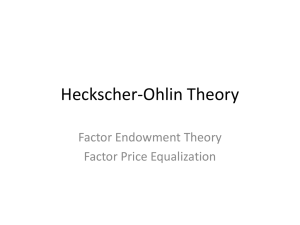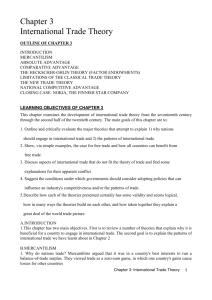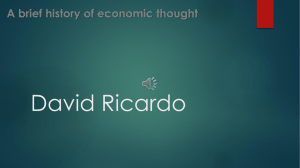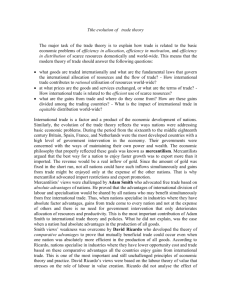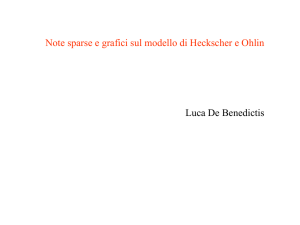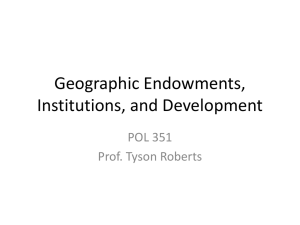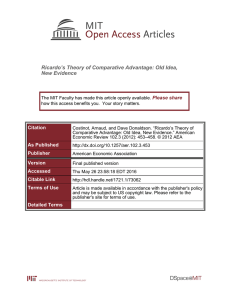International Trade Theory
advertisement
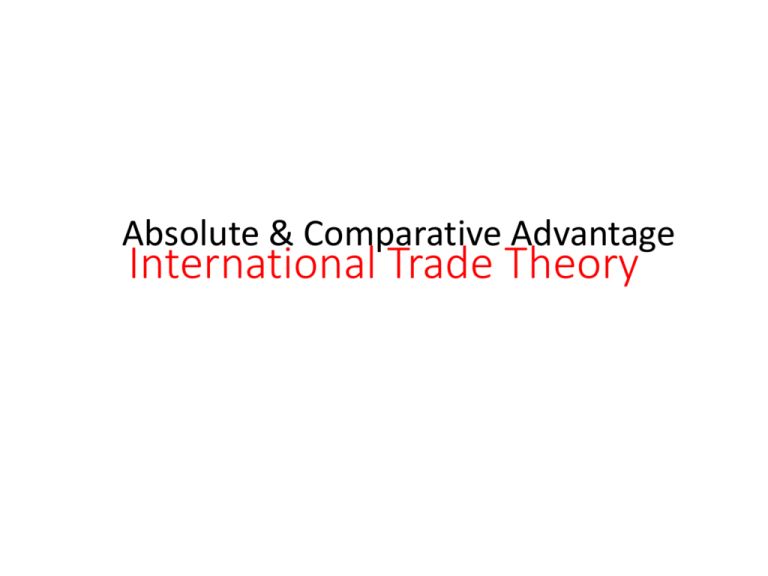
Absolute & Comparative Advantage International Trade Theory The Benefits Of Trade •Smith, Ricardo and Heckscher-Ohlin show why it is beneficial for a country to engage in international trade even for products it is able to produce for itself International trade allows a country: •to specialize in the manufacture and export of products that it can produce efficiently •import products that can be produced more efficiently in other countries Absolute Advantage • Export those goods and services for which a country is more productive than other countries • Import those goods and services for which other countries are more productive than it is The Theory of Absolute Advantage: An Example OUTPUT PER HOUR OF LABOR France Japan Wine 2 1 Clock radios 3 5 Absolute Advantage’s Flaw • What happens to trade if one country has an absolute advantage in both products? • No trade would occur Comparative Advantage • Produce and export those goods and services for which it is relatively more productive than other countries • Import those goods and services for which other countries are relatively more productive than it is The Theory of Comparative Advantage: An Example OUTPUT PER HOUR OF LABOR France Wine 4 Japan 1 9 Clock radios 6 4 5 6 11 The Theory of Comparative Advantage: An Example OUTPUT PER HOUR OF LABOR France Japan Wine 5 4 Clock radios 6 5 Adam Smith (1722-1790) is the most known economist of all times. In the work “Research of the nature and the reasons of the peoples wealth » (1776) he described a system of economic knowledge. Describe- описать A.Smith made an essential contribution to the study of the cost of goods. According to A.Smith, cost of the goods is defined only by work. This concept, the labor theory of cost, was going to play a huge role in the history of an economic science for it answered a question of wealth According to -по мнение the labor theory of cost- трудовая теория стоимости sources. (источник) A.Smith investigated the theory of money, the income, the capital, division of labor and reproduction. Reproduction - воспроизводство David Ricardo (1772-1823) continued traditions of classical political economy, having developed further A.Smith's ideas. D. Ricardo released the theory of labor cost from internal contradictions. labor cost- трудовая стоимость Release- освободить Internal contradiction – внутренное противоречие. He proved that cost is defined socially by necessary work. D. Ricardo explained the process of transferring the cost of means of production on a finished product. It was D. Ricardo's contribution to an economic science. Heckscher (1919)-Ohlin (1933) Differences in factor endowments not on differences in productivity determine patterns of trade Absolute amounts of factor endowments matter Heckscher (1919)-Olin (1933) • Labor is not the only Factor of production. We need to account for land, capital, and technology. • Factor endowments: extent to which a country is endowed with such resources as land, labor, and capital. • Export goods that intensively use factor endowments which are locally abundant. Theory of Relative Factor Endowments (Heckscher-Ohlin) Factor endowments vary among countries Products differ according to the types of factors that they need as inputs A country has a comparative advantage in producing products that intensively use factors of production (resources) it has in abundance Factor Endowments • Taken from Heckscher-Olin • Basic factors: • natural resources • climate • location • demographics • Advanced factors: • communications • skilled labor • research • technology
